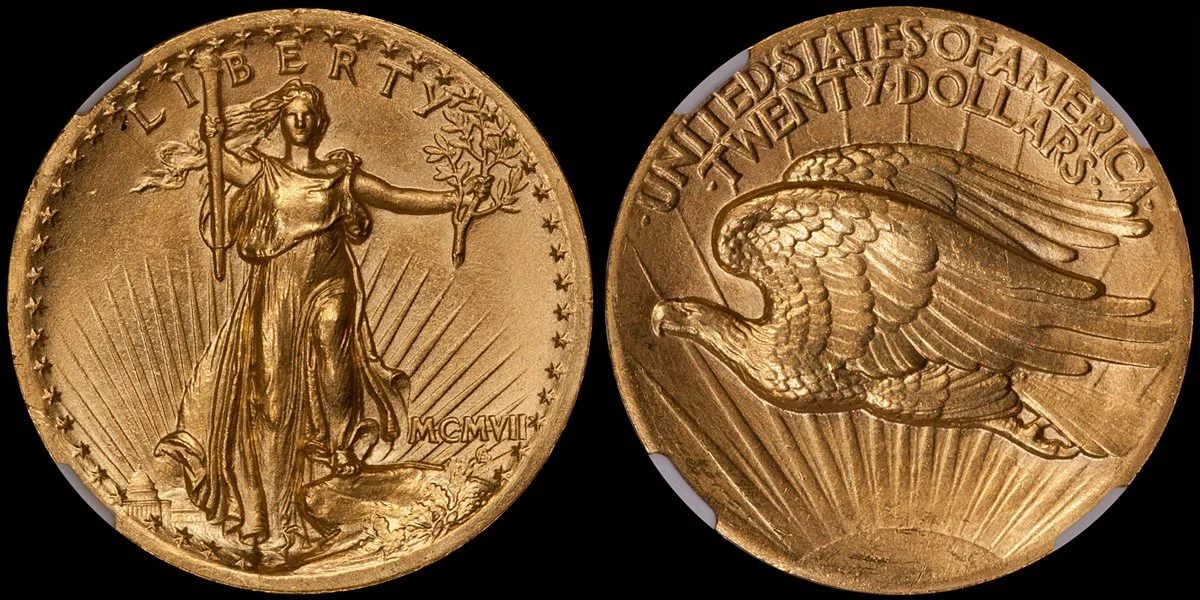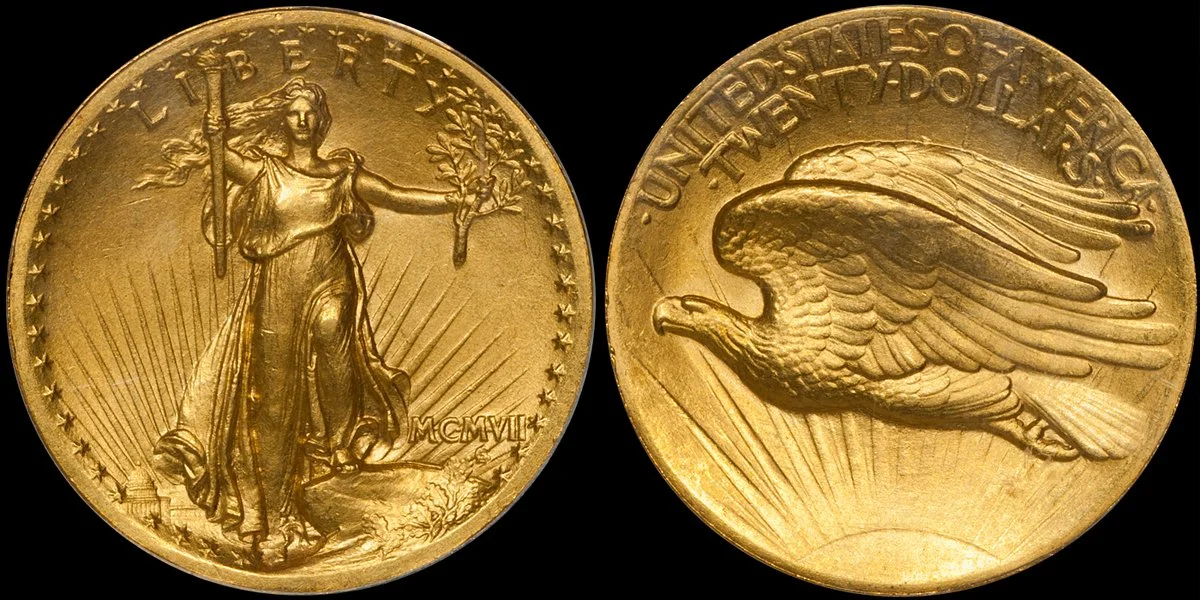What I Look for When I'm Buying a 1907 High Relief Double Eagle
/If you’ve got a large budget for US gold coins, the chances are good that at one time in your collecting life, you’ll buy a 1907 High Relief double eagle.
I think we can agree on the fact that this coin represents one of the more attractive regular issue designs on a US gold issue. I view the High Relief as one of the ultimate trophy coins, and the market clearly agrees given this coin’s high price relative to its availability.
Using the DWN system for determining the quality of a coin, let’s look at a High Relief like I do when I am contemplating the purchase of an example.
STRIKE: All High Relief double eagles are well-struck due to the fact that they were struck with multiple blows from the dies on a medal press. I regard strike as the least important factor in assessing US gold and it is basically meaningless when it comes to this issue.
SURFACES: If your budget is such that you are focusing on a circulated or lower-end Uncirculated example, you are going to have to deal with abrasions. It is not common for High Reliefs to be heavily abraded—as seen on a Liberty Head double eagle— as they were not shipped overseas as were many examples of this earlier design. However, it is not uncommon for AU55 to MS61 coins to show rim nicks or even dents which can be difficult to see in older NGC holders. A good number of the High Reliefs graded AU58 and lower have been cleaned or lightly polished at one time; most of these are still straight-graded by PCGS and NGC. Virtually all lower grade HRs show pronounced rub on the breast and left knee of Liberty.
MCMVII (1907) High Relief, Flat Edge, PCGS AU55 CAC
In the MS63 to MS65 range, High Reliefs are likely to show some light scuffs but none which are especially severe. The areas in which these marks are most likely to impact the grade are the upper left obverse field directly above the rays and towards the torch and on the reverse rays as well as on the sun. There is likely a slight flattening of Liberty’s breast and left knee but no actual wear. Many in this range have been dipped or lightened.
Coins graded MS66 and finer should have very few marks although one should not expect perfection or near-perfection from a US gold coin graded MS66 or even MS67. The surfaces on a superb gem will be natural with no blatant signs of modification.
MCMVII (1907) High Relief NGC MS62
LUSTER: There are essentially two types of luster seen on this issue. The more desirable of the two has a rich, frosty texture while the other is grainier with mint-made die polish evident. I personally prefer the former, but I would never reject a nice High Relief due to its having this activity visible in the fields.
A lower grade High Relief is going to show impaired luster but a nice AU58, as an example, may be a coin with the appearance of a MS62 or even an MS63 but with enough frost breaks to remove it from consideration at a higher level.
The luster on a coin in the MS63 to MS65 should be excellent. Here’s a trick I use to determine if the luster is original or not: look at the inner border on the reverse which is very open but which is hard for a coin doctor to reach. If the texture in this region matches the texture on the rest of the reverse, then the chances are strong that the coin in question has not been tampered with.
High Reliefs which grade MS66 and finer should have blazing luster.
COLORATION: A fairly broad spectrum of natural hues are seen on High Reliefs. The two most commonly seen colors are rich yellow-gold and medium green-gold. Other hues which are seen include orange-gold, rose-gold and rich reddish-gold.
MCMVII (1907) High Relief PCGS MS60 CAC Gold Sticker
On a lower grade High Relief, color isn’t going to be as significant a factor in determining its desirability as on a higher grade coin. My feeling is that if you can find an AU58 or an MS61 which has nice, seemingly natural color, it should be bought as such coins are not plentiful.
On an MS63 to MS65, color is more significant especially given the large number of coins which exist in this range. If you don’t like the color on an MS64 you are looking at, don’t fret; the right coin is likely just around the corner.
On a Superb Gem High Relief, color is extremely important. I would suggest that you run through past auction sales of high grade pieces and use the images to help determine which colors speak to you and which don’t. I’m not telling you that if you saw an MS66 HR which had rich rose-gold color that appealed to you that you should only buy one with similar hues. If you do this, you’ll likely pass on a coin which is just right for you.
EYE APPEAL: The overall eye appeal on a High Relief is the single most critical factor in deciding which coin you’ll wind-up buying.
If you have a budget of $10,000 you won’t be able to be picky and you’ll likely buy the first piece you see at this price point.
If you have a budget of $30,000-40,000+ you’ll be able to be very choosy. I would personally select an example which was graded by PCGS and approved by CAC.
If you have six figures budgeted for a High Relief, you should expect an exceedingly nice coin. Don’t consider one without CAC approval and if possible, wait for a coin with a provenance from a well-known gold coin generalist or—better yet—from a specialized collector of St. Gaudens double eagles. It may take six months or a year to locate the right coin but with CAC having approved 40 coins in MS66 as of 12/2022 you’ll have a few to choose from.
MCMVII (1907) High Relief, Flat Edge, PCGS MS65 CAC
A FEW FINAL THOUGHTS:
NGC designates certain High Reliefs as “Proofs.” It is my opinion that these are not Proofs but are merely early strikes which show a significant amount of die polish swirls particularly beneath the olive branch on the obverse. While undeniably interesting, these should command no premium.
Varieties of High Relief exist with a flat edge and a wire edge. The former is scarcer in all grades through MS65. It typically commands a small premium and, in my opinion, it is worth paying an extra 5-10% for one in MS63 through MS65 but not in grades above or below this range.
As I’ve stated numerous times in this blog, a High Relief is readily available in virtually any grade desired. I would personally select AU58 and MS64+ as the two best value grades for this issue. MS66 and MS67 High Reliefs are lovely to look at but unless you are doing an upper-end Registry Set of Saints, these grades seem like an overbuy to me.
Are you looking to buy a nice 1907 High Relief $20? I can assist you with this ad make certain you get the best coin for your coin dollars. Please call me at (214) 675-9897 or email me at dwn@ont.com to discuss.














